|
|
 |
Baked Eggnog Pumpkin Cheesecake—Prototype 1:
Eggnog Crust:
1/2 cup (8 oz.) whipped lowfat cottage cheese, no salt added
3 tablespoons granulated sugar
2 tablespoons brown sugar
1/4 teaspoon vanilla
1/4 teaspoon cinnamon
1/4 teaspoon nutmeg
1/2 teaspoon rum extract
1 teaspoon lemon juice
1/4 cup light eggnog
2.2 oz. finely ground Bran Buds
Pour (or press) into the pan, getting this crust evenly distributed. Next,
refrigerate for about half an hour, or until slightly firm. Afterwards, bake
at 300 degrees for 10 minutes (no bath at this point—just put the pan
directly on the rack), then remove from oven and cool down slightly (until
the pan is no longer too hot to the touch—about 5 minutes).
Pumpkin Batter:
2 tablespoons melted or softened butter
4 oz. pumpkin butter
1 tablespoon lemon juice
1/2 cup skim milk
1/2 cup granulated sugar
3/8 cup flour
1/4 teaspoon salt
2 1/2 cups (20 oz.) whipped lowfat cottage cheese, no salt added
2 eggs
Turn oven up to 325 degrees. Add the pumpkin batter on top of the crust.
Then put the foil on the pan (no earlier—less foil disturbance means less
leakage risk) and place into a hot bath. Bake for about 30 minutes. Tip:
When handling the pan-foil assembly at this point, lift it by the pan's rim,
not by the foil (let the foil cling to the pan's rim—optionally, you
can also position your fingers to hold the foil in place, but do not put
pressure on it to lift the entire pan—otherwise, the foil may tear).
Eggnog Batter:
2 tablespoons butter, softened or melted
2/3 cup granulated sugar
1 tablespoon lemon juice
1/2 tablespoon rum extract
1 teaspoon vanilla extract
2 1/2 cups (20 oz.) whipped lowfat cottage cheese, no salt added
2 cups of light eggnog
7/8 cup flour
1/4 teaspoon salt
1/2 teaspoon nutmeg
2 eggs
Carefully scoop this on top of the pumpkin batter, turn oven down to 300
degrees and resume baking for about 100 minutes.
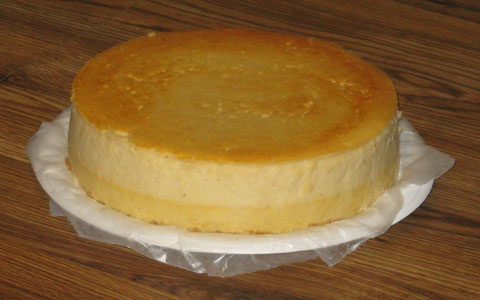
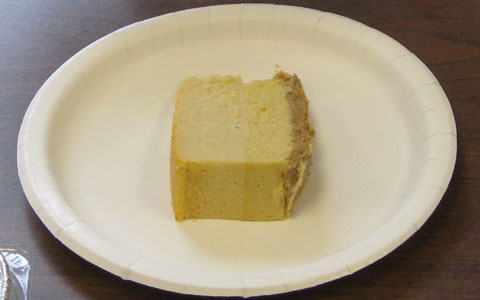
Baked Eggnog Pumpkin Cheesecake—Prototype 2:
Pumpkin Crust:
2 oz. melted, white chocolate
2 oz. pumpkin butter (such as from Trader Joe's)
1 cup (8 oz.) whipped lowfat cottage cheese, no salt added
1 teaspoon lemon juice
2 tablespoons granulated sugar
2 tablespoons brown sugar
1/2 teaspoon vanilla
2.2 oz. Bran Buds, ground up
Pour (or press) into the pan, refrigerate for about half an hour (at least),
then bake at 300 degrees for 15 minutes (no bath), then remove from oven and
cool to touch.
Pumpkin Batter:
2 tablespoons melted or softened butter
5/8 cup granulated sugar
8 oz. pumpkin butter
1 tablespoon lemon juice
1/2 cup skim milk
1/2 cup flour (whole white wheat, such as King Arthur)
1/4 teaspoon salt
3 cups (24 oz.) whipped lowfat cottage cheese, no salt added
2 eggs
Turn oven up to 325 degrees. Add pumpkin batter on top of crust. Put on
foil, place into hot bath. Bake for about 40 minutes.
Eggnog Batter:
2 tablespoons butter, softened or melted
2/3 cup granulated sugar
1 tablespoon lemon juice
1 teaspoon rum extract
1 teaspoon vanilla extract
2 cups (16 oz.) whipped lowfat cottage cheese, no salt added
2 cups of light eggnog
3/4 cup flour (whole white wheat, such as King Arthur)
1/4 teaspoon salt
1/2 teaspoon nutmeg
2 eggs
Carefully scoop this on top of the pumpkin batter, turn oven down to 300
degrees and resume baking for about 120 minutes.
Remove from oven and cool for 3 hours before removing from pan, then
refrigerate (at least for a few hours, allowing the cheesecake to get more
firm).
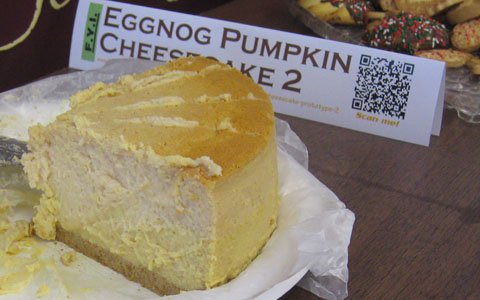
Baked Eggnog Pumpkin Cheesecake—Prototype 3:
2-to-1 Blend of Yogurt Cheese and Cottage Cheese:
Prepare ahead of time 2 pounds of yogurt cheese, derived from two 32-ounce
containers of nonfat yogurt. If the resulting yogurt cheese falls below 32
ounces, add back enough of the whey (that was strained out from the yogurt) to
make up the difference. To this yogurt cheese combine 16 ounces (1 pint) of
whipped, lowfat cottage cheese.
Crust:
2 oz. melted, white chocolate
1 cup (8 oz.) 2-to-1 blend of yogurt cheese and cottage cheese (see above)
1/4 cup granulated sugar
2 2/3 tablespoons brown sugar
2 teaspoons cinnamon
1/2 teaspoon vanilla extract
2.2 oz. Bran Buds, ground up
Pour this crust mixture into pan (9 to 9 1/2 inches) and pre-bake without tub at
300 degrees for 10 minutes, then cool enough to comfortably touch at least the
pan's upper sidewall.
Eggnog Batter:
2 tablespoons butter, softened or melted
2/3 cup granulated sugar
2 cups (16 oz.) 2-to-1 blend of yogurt cheese and cottage cheese (see above)
2 tablespoons all-purpose flour
1/4 cup arrowroot
1/4 teaspoon salt
1/2 teaspoon nutmeg
1 teaspoon vanilla extract
1 teaspoon rum extract
2 cups light eggnog
2 eggs
Turn oven up to 325 degrees. Add eggnog batter on top of crust. Put on foil,
place into hot bath. Bake for about 40 minutes.
Pumpkin Batter:
2 tablespoons melted or softened butter
5/8 cup granulated sugar
3 cups (24 oz.) 2-to-1 blend of yogurt cheese and cottage cheese (see above)
2 tablespoons all-purpose flour
2 tablespoons arrowroot
1/4 teaspoon salt
1 teaspoon vanilla extract
8 oz. pumpkin butter
2 eggs
Carefully scoop this on top of the eggnog batter, turn oven down to 300 degrees
and resume baking for about 120 minutes (if using a 9 1/2" pan). Then cool
down while still in oven (with this oven shut off) and in tub with door slightly
ajar for an hour. Afterwards, remove from oven and tub and continue to cool down
at room temperature for another 3 hours, then remove from pan and refrigerate
(at least for a few hours, allowing the cheesecake to get more firm).
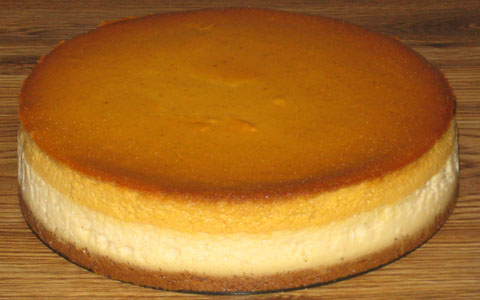
Baked Eggnog Pumpkin Cheesecake—Prototype 4:
2-to-1 Blend of Yogurt Cheese and Cottage Cheese:
Prepare ahead of time 2 pounds of yogurt cheese, derived from two 32-ounce
containers of nonfat yogurt. If the resulting yogurt cheese falls below 32
ounces, add back enough of the whey (that was strained out from the yogurt) to
make up the difference. To this yogurt cheese combine 16 ounces (1 pint) of
whipped, lowfat cottage cheese.
Crust:
2 oz. melted, white chocolate
1 cup (8 oz.) 2-to-1 blend of yogurt cheese and cottage cheese (see above)
1/4 cup granulated sugar
2 2/3 tablespoons brown sugar
2 teaspoons cinnamon
1/2 teaspoon vanilla extract
2.2 oz. Bran Buds, ground up
Pour this crust mixture into pan (9 to 9 1/2 inches) and pre-bake without tub at
300 degrees for 10 minutes, then cool enough to comfortably touch at least the
pan's upper sidewall.
Pumpkin Batter:
2 tablespoons melted or softened butter
5/8 cup granulated sugar
3 cups (24 oz.) 2-to-1 blend of yogurt cheese and cottage cheese (see above)
2 tablespoons all-purpose flour
2 tablespoons arrowroot
1/4 teaspoon salt
1 teaspoon vanilla extract
9 oz. pumpkin butter
2 eggs
Turn oven up to 325 degrees. Add pumpkin batter (all of it) on top of crust. Put
on foil, place into hot bath. Bake for about 40 minutes.
Eggnog Batter:
2 tablespoons butter, softened or melted
2/3 cup granulated sugar
2 cups (16 oz.) 2-to-1 blend of yogurt cheese and cottage cheese (see above)
2 tablespoons all-purpose flour
1/4 cup arrowroot
1/4 teaspoon salt
1/2 teaspoon nutmeg
1 teaspoon vanilla extract
1 teaspoon rum extract
2 cups light eggnog
2 eggs
Carefully scoop this on top of the pumpkin batter, filling up the springform pan
within its capacity (set aside any remaining eggnog batter). Then turn oven down
to 300 degrees and resume baking for about 120 minutes (if using a 9 1/2"
pan). Next, cool down while still in oven (with this oven shut off) and in tub
with door slightly ajar for an hour. Afterwards, remove from oven and tub and
continue to cool down at room temperature for another 3 hours, then remove from
pan and refrigerate (at least for a few hours, allowing the cheesecake to get
more firm).
As for any remaining eggnog batter (which will probably not be much), grab a few
baking cups, pour the batter into them, bake these cupcake-style eggnog
cheesecakes at 300 degrees for about 50 minutes (go ahead, put them in the same
oven as the big cheesecake, but don't bother immersing them in a tub), cool for
about 50 minutes afterward, chill for a least a few hours—and enjoy!
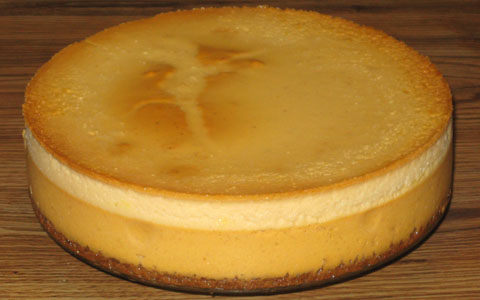
Baked Eggnog Pumpkin Cheesecake—Prototype 5:
2-to-1 Blend of Yogurt Cheese and Cottage Cheese:
Prepare ahead of time 2 pounds of yogurt cheese, derived from two 32-ounce
containers of nonfat yogurt. If the resulting yogurt cheese falls below 32
ounces, add back enough of the whey (that was strained out from the yogurt) to
make up the difference. To this yogurt cheese combine 16 ounces (1 pint) of
whipped, lowfat cottage cheese.
Crust:
2 oz. melted, white chocolate
8 oz. (1 cup) 2-to-1 blend of yogurt cheese and cottage cheese (see above)
1/4 cup granulated sugar
1/4 cup brown sugar
2 teaspoons cinnamon
1/2 teaspoon vanilla
2 oz. All-Bran, ground up
Pour this crust mixture into pan (9 to 9 1/2 inches) and pre-bake without tub at
300 degrees for 10 minutes, then cool enough to comfortably touch at least the
pan's upper sidewall.
Eggnog Batter:
2 tablespoons melted or softened butter
2/3 cup granulated sugar
1 teaspoon rum extract
1 teaspoon vanilla extract
2 1/2 cups (20 oz.) 2-to-1 blend of yogurt cheese and cottage cheese (see above)
2 cups light eggnog
2 tablespoons all-purpose flour
3/8 cup arrowroot
1/2 teaspoon nutmeg
2 eggs
Wrap the pan in foil, and pour the eggnog batter on top of the crust, no higher
than halfway from the crust's surface to the top of the pan (if there is any
excess batter, use it to make "cupcakes", baking these at 300 degrees
for 50 minutes using a bath arrangement—or use this batter together with
a good pancake mix to make pancakes). Then place this pan in a tub—filled
only about halfway, or about half an inch, with boiling water. Bake all this at
325 degrees for about 60 minutes. Then take the whole pan-and-tub setup out of
the oven, and carefully get it to a comfortable place. Promptly add the pumpkin
batter as indicated below.
Pumpkin Batter:
2 tablespoons melted or softened butter
1/2 cup granulated sugar
1 teaspoon vanilla extract
2 1/2 cups (20 oz.) 2-to-1 blend of yogurt cheese and cottage cheese (see above)
7 oz. pumpkin butter
2 tablespoons all-purpose flour
1 1/2 tablespoons arrowroot
2 eggs
Carefully scoop this on top of the eggnog batter and return the pan-and-tub
setup to oven, this time at only 300 degrees, and add more hot water to the tub
(at this point, go ahead and fill it all the way). Bake for about 120 more
minutes.
Turn oven off, leaving cheesecake in it (still in tub as well), with the door
slightly ajar, for another 60 minutes.
Remove cheesecake from oven and tub and let cool in its pan at room temperature
for another 120 minutes.
Afterwards, remove cheesecake from pan and refrigerate.
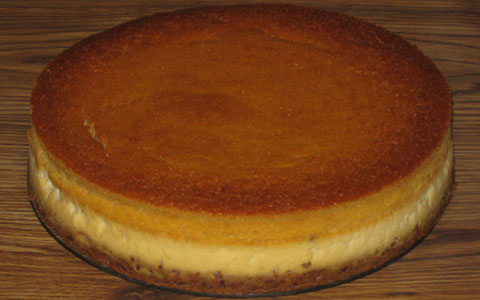
Baked Eggnog Pumpkin Cheesecake—Prototype 6:
2-to-1 Blend of Yogurt Cheese and Cottage Cheese:
Prepare ahead of time 2 pounds of yogurt cheese, derived from two 32-ounce
containers of nonfat yogurt. If the resulting yogurt cheese falls below 32
ounces, add back enough of the whey (that was strained out from the yogurt) to
make up the difference. To this yogurt cheese combine 16 ounces (1 pint) of
whipped, lowfat cottage cheese.
Crust:
2 oz. melted, white chocolate
8 oz. (1 cup) 2-to-1 blend of yogurt cheese and cottage cheese (see above)
1/4 cup granulated sugar
1/4 cup brown sugar
2 teaspoons cinnamon
1 teaspoon vanilla
2 oz. All-Bran, ground up
Pour this crust mixture into pan (9 to 9 1/2 inches) and pre-bake without tub at
300 degrees for 10 minutes, then cool enough to comfortably touch at least the
pan's upper sidewall.
Eggnog Batter:
2 tablespoons melted or softened butter
2/3 cup granulated sugar
1 teaspoon rum extract
1 teaspoon vanilla extract
2 1/2 cups (20 oz.) 2-to-1 blend of yogurt cheese and cottage cheese (see above)
2 cups light eggnog
2 tablespoons all-purpose flour
3/8 cup arrowroot
1/2 teaspoon nutmeg
2 eggs
Wrap the pan in foil, and pour the eggnog batter on top of the crust, no higher
than halfway from the crust's surface to the top of the pan
(for suggestions on what to do with any excess batter, see Prototype 5 of this cheesecake).
Then place this
pan in a tub—filled slightly more than halfway, or about 3/4 of an inch,
with boiling water. Bake all this at 325 degrees for about 60 minutes. Next,
lower the temperature to 300 degrees and continue baking for another 15 minutes.
Then take the whole pan-and-tub setup out of the oven, and carefully get it to a
comfortable place. Promptly add the pumpkin batter as indicated below.
Pumpkin Batter:
2 tablespoons melted or softened butter
1/2 cup granulated sugar
1 teaspoon vanilla extract
2 1/2 cups (20 oz.) 2-to-1 blend of yogurt cheese and cottage cheese (see above)
7 oz. pumpkin butter
2 tablespoons all-purpose flour
1 1/2 tablespoons arrowroot
2 eggs
Carefully scoop this on top of the eggnog batter and return the pan-and-tub
setup to oven, still at 300 degrees, and add more hot water to the tub (at this
point, go ahead and fill it all the way). Bake for about 105 more minutes. After
that, turn oven off, leaving cheesecake in it (still in tub as well), with the
door slightly ajar, for another 60 minutes. Next, remove cheesecake from oven
and tub and let cool in its pan at room temperature for another 120 minutes.
Afterwards, remove cheesecake from pan and refrigerate.
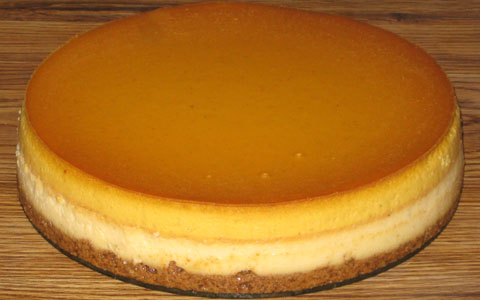
|
|

|